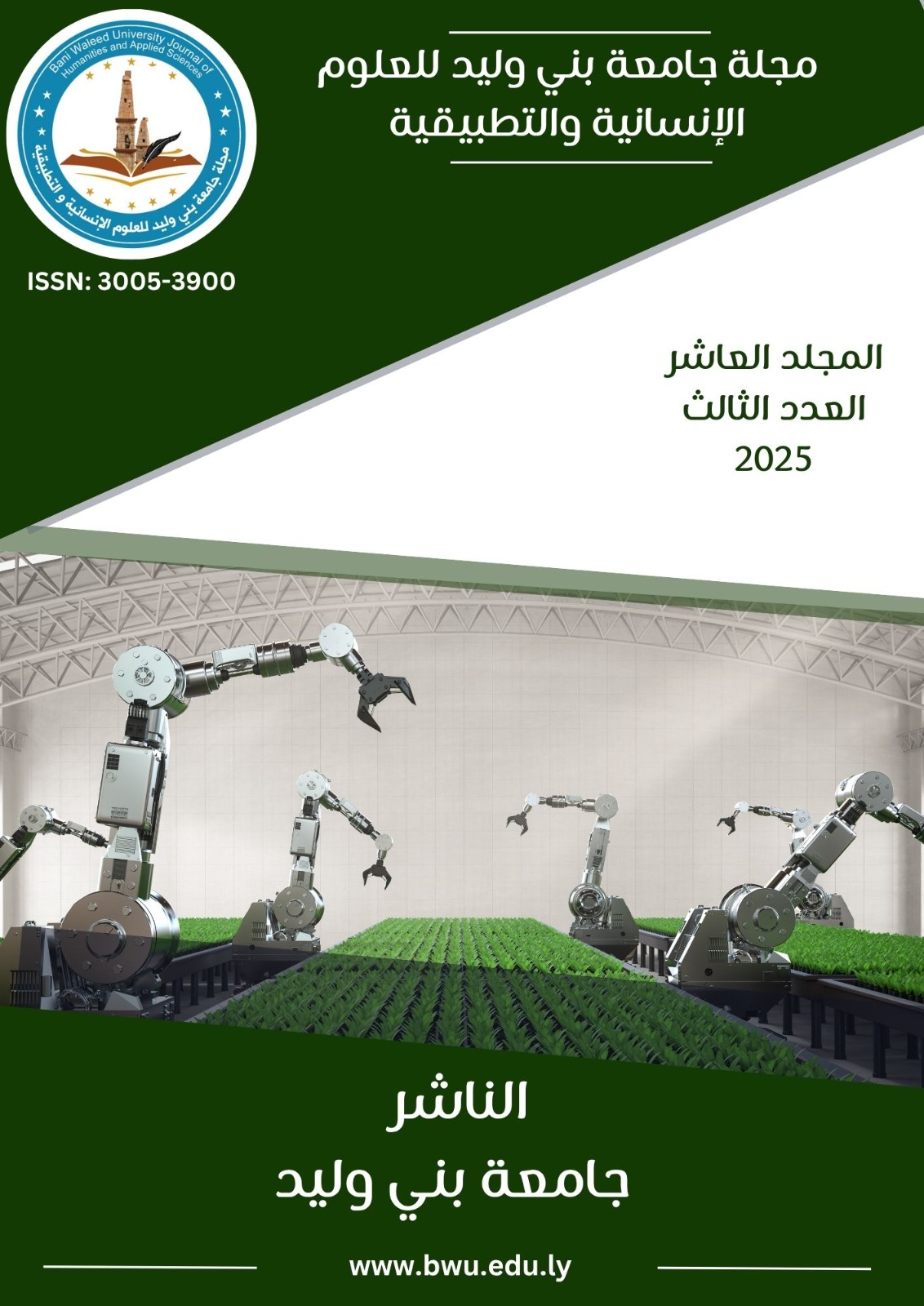Paulownia Cultivation in Libya: Soil Improvement, Growth Potential, and Economic Benefits: A Review Article
DOI:
https://doi.org/10.58916/jhas.v10i3.894الكلمات المفتاحية:
tomentosa، Sustainable agriculture، Soil improvement، Carbon sequestration، Reforestation، Libyaالملخص
Paulownia tomentosa, known as the empress tree, is a fast-growing species native to China. This study reviews its botanical characteristics, environmental and economic benefits, agricultural applications, and cultivation challenges.The tree improves soil quality and water retention while effectively sequestering carbon dioxide, making it valuable for climate change mitigation. Its lightweight timber is commercially useful, and its leaves serve as a high-protein livestock feed, promoting sustainable agriculture. In Libya, Paulownia tomentosa can enhance agricultural productivity through reforestation and soil quality improvement. However, challenges include uncontrolled spread and susceptibility to pests and diseases. The research emphasizes developing management strategies to address these issues and ensure sustainability.
التنزيلات
المراجع
Aizen M.A., Harder L.D. (2009). The global stock of domesticated honey bees is growing slower than agricultural demand for pollination. Current Biology, Volume 19, Issue 11, pp 915–918
Akyildiz, M.H., & Kol, H.Ş. (2010). Some technological properties and uses of paulownia (Paulownia tomentosa Steud.) wood. Journal of environmental biology, 31 3, 351-5 .
Alagawany, M., Farag, M. R., Sahfi, M. E., Elnesr, S. S., Alqaisi, O., El-Kassas, S., ... & Abd E-Hack, M. E. (2022). Phytochemical characteristics of Paulownia trees wastes and its use as unconventional feedstuff in animal feed. Animal Biotechnology, 33(3), 586-593.
Aloi, F., Riolo, M., La Spada, F., Bentivenga, G., Moricca, S., Santilli, E., ... & Cacciola, S. O. (2021). Phytophthora root and collar rot of Paulownia, a new disease for Europe. Forests, 12(12), 1664.
Al-Sagheer, A. A., Abd El-Hack, M. E., Alagawany, M., Naiel, M. A., Mahgoub, S. A., Badr, M. M., ... & Swelum, A. A. (2019). Paulownia leaves as a new feed resource: Chemical composition and effects on growth, carcasses, digestibility, blood biochemistry, and intestinal bacterial populations of growing rabbits. Animals, 9(3), 95.
Bakalár, T., Pavolová, H., Lacko, R., & Hajduová, Z. (2023). The Sustainable Revitalization Potential of Agricultural Brownfield-a Case Study of East Slovakia. Polish Journal of Environmental Studies, 32(2): 1049-1059
Barbu, M. C., Buresova, K., Tudor, E. M., & Petutschnigg, A. (2022). Physical and mechanical properties of Paulownia tomentosa x elongata sawn wood from Spanish, Bulgarian and Serbian plantations. Forests, 13(10), 1543.
Barton, I.L., Nicholas, I.D., Ecroyd, C.E. (2007). Paulownia. Forest Research Bulletin No 231. Sustainable Farming Fund.
Berdón Berdón, J., Montero Calvo, A. J., Royano Barroso, L., Parralejo Alcobendas, A. I., & González Cortés, J. (2017). Study of Paulownia’s biomass production in mérida (badajoz), southwestern Spain. Environ. Ecol. Res, 5, 521-527.
Bikfalvi, M. (2014). Paulownia – The intelligent tree. Paulownia GreenE.
Bodnár, Á., Steier, J., Szabó, R. T., Póti, P., Egerszegi, I., & Pajor, F. (2020). Feeding experiences of Paulownia spp. leaves: Potential forage source for domestic animals. International Journal of Zoology and Animal Biology, 3, 1-4.
Breeze, T. D., Vaissière, B. E., Bommarco, R., Petanidou, T., Seraphides, N., Kozák, L., Scheper, J., Biesmeijer, J. C., Kleijn, D., Gyldenkærne, S., Moretti, M., Holzschuh, A., Steffan-Dewenter, I., Stout, J. C., Pärtel, M., Zobel, M., & Potts, S. G. (2014). Agricultural policies exacerbate honeybee pollination service supply-demand mismatches across Europe. PLOS ONE, 9(1).
Buzan, R. L., Maxim, A., Odagiu, A., Balint, C., & Hărțăgan, R. M. (2018). Paulownia sp. Used as an Energetic Plant, for the Phytoremediation of Soils and in Agroforestry Systems. ProEnvironment Promediu, 11(34).
Costea, M., DANCI, M., CIULCA, S., & SUMALAN, R. (2021). Genus Paulownia: Versatile woodspecies with multiple uses-A review. Life science and sustainable development, 2(1), 32-40.
Costea, M., DANCI, M., CIULCA, S., & SUMALAN, R. (2021). Genus Paulownia: Versatile woodspecies with multiple uses-A review. Life science and sustainable development, 2(1), 32-40.
Du, T., Wang, Y., HU, Q. X., Chen, J., Liu, S., HUANG, W. J., & LIN, M. L. (2005). Transgenic Paulownia expressing shiva‐1 gene has increased resistance to paulownia witches' broom disease. Journal of Integrative Plant Biology, 47(12), 1500-1506.
Erbar, C., & Gülden, C. (2011). Ontogeny of the flowers in Paulownia tomentosa–A contribution to the recognition of the resurrected monogeneric family Paulowniaceae. Flora-Morphology, Distribution, Functional Ecology of Plants, 206(3), 205-218.
Fung, K. M., Tai, A. P., Yong, T., Liu, X., & Lam, H. M. (2019). Co-benefits of intercropping as a sustainable farming method for safeguarding both food security and air quality. Environmental Research Letters, 14(4), 044011.
Ghazzawy, H. S., Bakr, A., Mansour, A. T., & Ashour, M. (2024). Paulownia trees as a sustainable solution for CO2 mitigation: assessing progress toward 2050 climate goals. Frontiers in Environmental Science, 12, 1307840.
Ghazzawy, H. S., Bakr, A., Mansour, A. T., & Ashour, M. (2024). Paulownia trees as a sustainable solution for CO2 mitigation: assessing progress toward 2050 climate goals. Frontiers in Environmental Science, 12, 1307840.
Glaze-Corcoran, S., Hashemi, M., Sadeghpour, A., Jahanzad, E., Afshar, R. K., Liu, X., & Herbert, S. J. (2020). Understanding intercropping to improve agricultural resiliency and environmental sustainability. Advances in agronomy, 162, 199-256.
Guo, N., Zhai, X. Q., & Fan, G. Q. (2023). Chemical composition, health benefits and future prospects of Paulownia flowers: A review. Food chemistry, 412, 135496.
Humentyk, M.Y., & Bordus, O.Y. (2023). Peculiarities of plant growth, development, and chemical composition of the Paulownia biomass. Advanced Agritechnologies.
Hussien, E. T. (2020). Production of transgenic Paulownia tomentosa (Thunb.) steud. using chitosan nanoparticles to express antimicrobial genes resistant to bacterial infection. Molecular Biology Research Communications, 9(2), 55.
Ivaniuk, A., Kharachko, T., Lysiuk, R., Danchuk, O., & Cheban, O.(2023). Paulownia tomentosa (Thunb.) Steud. seed quality from different geographical locations in Ukraine. forestry ideas vol. 29, No 2 (66): 314–326
Jensen, J. B. (2016). An investigation into the suitability of Paulownia as an agroforestry species for UK & NW European farming systems (Master’s thesis, SRUC). Department of Agriculture & Business Management.
Jiang, Z., Gao, L., Fang, Y., & Sun, X. (1994). Analysis of Paulownia-intercropping types and their benefits in Woyang County of Anhui Province. Forest Ecology and Management, 67(1-3), 329-337.
Johnson, J. E., Mitchem, D. O., & Kreh, R. E. (2002). The relationship between soils and foliar nutrition for planted royal paulownia. In Proceedings eleventh biennial southern silvicultural research conference. Gen. Tech. Rep. SRS-48. US Forest Service, Southern Research Station, Asheville, NC (pp. 239-244).
Kozakiewicz, P., Laskowska, A., & Ciolek, S. (2020). A study of selected features of Shan Tong variety of plantation paulownia and its wood properties. Annals of Warsaw University of Life Sciences-SGGW. Forestry and Wood Technology, 111. 116-123
Liu, S., Li, P., Gan, W., Fu, Y., Weng, Y., Tu, J., ... & Wu, L. (2022). Effect of long‐term fertilization on soil microbial activities and metabolism in Paulownia plantations. Soil Use and Management, 38(1), 978-990.
Liu, S., Li, P., Gan, W., Fu, Y., Weng, Y., Tu, J., ... & Wu, L. (2022). Effect of long‐term fertilization on soil microbial activities and metabolism in Paulownia plantations. Soil Use and Management, 38(1), 978-990.
Madejón, P., Alaejos, J., García-Álbala, J., Fernández, M., & Madejón, E. (2016). Three-year study of fast-growing trees in degraded soils amended with composts: Effects on soil fertility and productivity. Journal of environmental management, 169, 18-26.
Madejón, P., Xiong, J., Cabrera, F., & Madejón, E. (2014). Quality of trace element contaminated soils amended with compost under fast growing tree Paulownia fortunei plantation. Journal of environmental management, 144, 176-185.
Magar, L. B., Khadka, S., Joshi, J. R. R., Pokharel, U., Rana, N., Thapa, P., ... & Parajuli, N. (2018). Total biomass carbon sequestration ability under the changing climatic condition by Paulownia tomentosa Steud. International Journal of Applied Sciences and Biotechnology, 6(3), 220-226.
Mamirova, A., Baubekova, A., Pidlisnyuk, V., Shadenova, E., Djansugurova, L., & Jurjanz, S. (2022). Phytoremediation of soil contaminated by organochlorine pesticides and toxic trace elements: Prospects and limitations of Paulownia tomentosa. Toxics, 10(8), 465.
Marana, B. (2018). A green GIS solution against air pollution in the Province of bergamo: the paulownia tree. Journal of Geographic Information System, 10(2), 193-218.
Mehrotra, M. D. (1997). Diseases of Paulownia and their management. 66-72.
Pasiecznik, N. (2022). Paulownia tomentosa (paulownia). CABI Compendium.
Paulownia Europa (2012). Why Paulownia?
Rao, A. N. (1986). Paulownia in China: cultivation and utilization. Asian Network for Biological Sciences, Singapore, SG. pp. 1-65
Tomasz, S. A., Anita, Z., Łukasz, F., Justyna, K. J., Łukasz, J., Wojciech, L., & Czesław, P. (2022). Plant Parasitic Nematodes on Paulownia tomentosa in Poland. Journal of Horticultural Research, 30(1), 31-40
Tor-Ngern, P., & Leksungnoen, N. (2020). Investigating carbon dioxide absorption by urban trees in a new park of Bangkok, Thailand. BMC ecology, 20(1), 20.
WAN, F. (2003). Review on the research of paulownia-crops intercropping in recent twenty years. Journal of Nanjing Forestry University, 46(05), 88.













